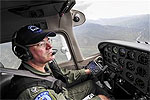CAP simulates threats, assists RF-A pilots
 EIELSON AIR FORCE BASE, Alaska -- During RED FLAG-Alaska, fighter aircraft dominate the skies. Participating forces identify hostile targets while waging a simulated war - but not all hostiles are fighters.
EIELSON AIR FORCE BASE, Alaska -- During RED FLAG-Alaska, fighter aircraft dominate the skies. Participating forces identify hostile targets while waging a simulated war - but not all hostiles are fighters.
Eielson's own Civil Air Patrol 71st Composite Squadron plays a role during RF-A by simulating Antonov An-2 Colts, primarily using a deHavilland Canada DHC-2 Beaver aircraft. Their presence gives fighter pilots the opportunity to train in visually identifying low-flying, special operations forces-carrying aircraft.
Steve Brewer, 71st CS commander, said CAP's participation allows pilots to incorporate the defensive counter-air function of detection, identification and interception of enemy aircraft into the training scenario.
"The training that fighter pilots get by visually identifying their targets has been proven over history to be important in positively identifying targets," he said. "RED FLAG is one of the few venues that allow pilots to train for this mission type."
Brewer, a former Air Force fighter pilot, said the emphasis of the training mission is not solely on CAP's aircraft because RF-A pilots are defending against multiple targets. However, identifying and stopping low-flying threats are objectives that RF-A participants train for.
"While we don't react to pilots because we aren't out there to fight, CAP is still a training aid for RED FLAG participants during the exercise," Brewer said. "We're out there to help them learn and overcome obstacles they're faced with."
Including CAP into RF-A has provided participants with an extra level of challenges they might not have back at their home station, said Maj. Bryan McGuire, 18th Aggressor Squadron mission commander.
"Through RED FLAG-Alaska, the 354th Fighter Wing can prepare aircrew to fight in relatively unrestricted air space," McGuire said. "Including CAP in the scenario forces fighters to defend a lane in three dimensions, and it teaches them to successfully sanitize a much larger volume of space."
In terms of realistic threat scenarios, low-flying, slow-moving aircraft is one that aircrew must prepare for, McGuire added. In this way, CAP delivers a means to do so.
CAP's integration with RF-A has proven over the years to be invaluable by providing a cost-effective training method, allowing the Air Force and its partners to receive unparalleled air combat experiences.